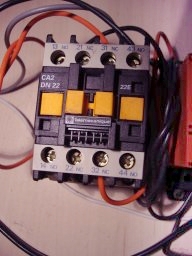
Electrical Contacts With 2D Materials: Current Developments and Future Prospects.
Sign Up to like & getrecommendations! Published in 2023 at "Small"
DOI: 10.1002/smll.202206550
Abstract: Current electrical contact models are occasionally insufficient at the nanoscale owing to the wide variations in outcomes between 2D mono and multi-layered and bulk materials that result from their distinctive electrostatics and geometries. Contrarily, devices… read more here.
Keywords: current developments; materials current; electrical contact; electrical contacts ... See more keywords

The importance of the electrical contact between specimen and testing fixture in evaluating the electromagnetic interference shielding effectiveness of carbon materials
Sign Up to like & getrecommendations! Published in 2017 at "Carbon"
DOI: 10.1016/j.carbon.2017.02.091
Abstract: Abstract The quality of the electrical contact between the specimen and electromagnetic interference (EMI) shielding testing fixture (coaxial cable method) is found to be critical to shielding effectiveness testing. The carbon fiber (CF) mat (0.15–0.42 mm… read more here.
Keywords: mat; electrical contact; contact specimen; shielding effectiveness ... See more keywords

Air arc erosion behavior of CuZr/Zn2SnO4 electrical contact materials
Sign Up to like & getrecommendations! Published in 2018 at "Journal of Alloys and Compounds"
DOI: 10.1016/j.jallcom.2018.01.326
Abstract: Abstract Cu-based composites are considered as one of the high performance and cost-effective materials to replace the noble metal-based electrical contact materials used in low-voltage electrical apparatus. However, the oxidation resistance of Cu-based electrical contact… read more here.
Keywords: contact materials; cuzr zn2sno4; electrical contact; contact ... See more keywords

Anisotropic properties of Ag/Ti3AlC2 electrical contact materials prepared by equal channel angular pressing
Sign Up to like & getrecommendations! Published in 2019 at "Journal of Alloys and Compounds"
DOI: 10.1016/j.jallcom.2019.01.083
Abstract: Abstract Equal channel angular pressing (ECAP) was introduced firstly to prepare Ag/Ti3AlC2 electrical contact materials. Ag/10 wt% Ti3AlC2 composite with a relative density of 99.8% and refined microstructure was prepared by ECAP at a relatively low… read more here.
Keywords: ti3alc2 electrical; angular pressing; ecaped sample; electrical contact ... See more keywords

Superior electrical contact characteristics of Ag/CNT composite films formed in a cyanide-free plating bath and tested against corrosion by H2S gas
Sign Up to like & getrecommendations! Published in 2021 at "Materials Letters"
DOI: 10.1016/j.matlet.2021.130504
Abstract: Abstract The electrical contact resistance of a Ag/carbon nanotube (CNT) composite plating film prepared using a cyanide-free bath was evaluated against a H2S gas corrosion test. After the corrosion test, the Ag/CNT composite plating film… read more here.
Keywords: electrical contact; cnt composite; h2s gas; corrosion ... See more keywords

Method for evaluating interfacial resistances of thermoelectric devices using I-V measurement
Sign Up to like & getrecommendations! Published in 2018 at "Measurement"
DOI: 10.1016/j.measurement.2018.07.030
Abstract: Abstract Research on the methodology for predicting and analyzing the performance of a thermoelectric device (TED) can offer various possibilities for enhancing its energy conversion characteristics. In this work, the methodology to determine the electrical… read more here.
Keywords: methodology; interfacial thermal; electrical contact; thermal resistance ... See more keywords

Scalable fabrication and electrical contact formation process for vertically oriented silicon nanopillars in trenches
Sign Up to like & getrecommendations! Published in 2021 at "Materials Science in Semiconductor Processing"
DOI: 10.1016/j.mssp.2020.105470
Abstract: Abstract Vertical silicon nano-pillars (Si N-Pls) inside the cylindrical trenches have been fabricated as a prospective platform for the development of silicon nanowire based devices. Deep reactive ion etching (DRIE) has been used to etch… read more here.
Keywords: scalable fabrication; nano pillars; electrical contact; silicon ... See more keywords

Prediction of electrical contact resistance failure of Ag/Ag plated contact subjected to complex fretting-reciprocating sliding
Sign Up to like & getrecommendations! Published in 2017 at "Wear"
DOI: 10.1016/j.wear.2016.12.033
Abstract: Abstract Electronic connectors are extensively used in the car industry. However, due to engine vibration, fretting wear damage can decay the electrical contact resistance. In addition to small fretting oscillations, the connectors are subjected to… read more here.
Keywords: contact resistance; electrical contact; reciprocating sliding; contact subjected ... See more keywords

Seamless Staircase Electrical Contact to Semiconducting Graphene Nanoribbons.
Sign Up to like & getrecommendations! Published in 2017 at "Nano letters"
DOI: 10.1021/acs.nanolett.7b02938
Abstract: Electrical contact to low-dimensional (low-D) materials is a key to their electronic applications. Traditional metal contacts to low-D semiconductors typically create gap states that can pin the Fermi level (EF). However, low-D metals possessing a… read more here.
Keywords: graphene nanoribbons; seamless staircase; electrical contact; staircase electrical ... See more keywords

Variations in the Effective Work Function of Graphene in a Sliding Electrical Contact Interface under Ambient Conditions.
Sign Up to like & getrecommendations! Published in 2022 at "ACS applied materials & interfaces"
DOI: 10.1021/acsami.2c02096
Abstract: Control of work function (WF) in graphene is crucial for graphene application in electrode material replacement and electrode surface protection in optoelectronic devices. Although efforts have been made to manipulate the effective WF of graphene… read more here.
Keywords: graphene; contact; spectroscopy; microscopy ... See more keywords

Electrical contact barriers between 3D metal and layered SnS2.
Sign Up to like & getrecommendations! Published in 2020 at "ACS applied materials & interfaces"
DOI: 10.1021/acsami.9b21996
Abstract: Field-effect transistors derived from traditional 3D semiconductors are rapidly approaching their fundamental limits. Layered semiconducting materials have emerged as promising candidates to replace restrictive 3D semiconductor materials. However, contacts between metals and layered materials deviate… read more here.
Keywords: sns2; contact barriers; electrical contact; barriers metal ... See more keywords